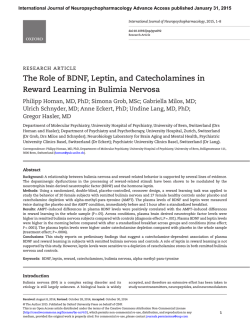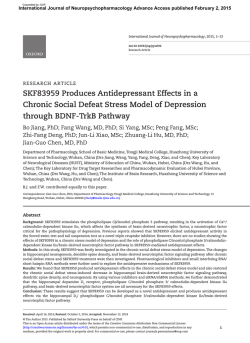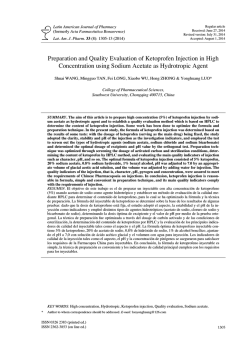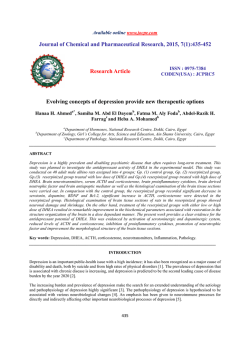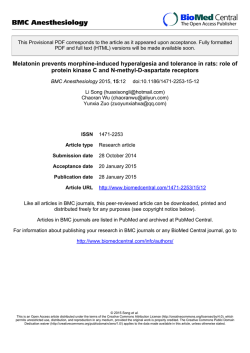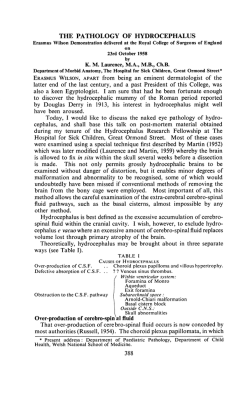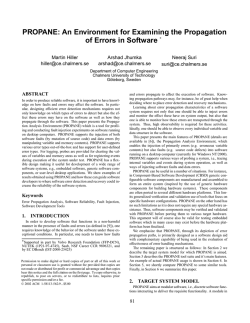
Comparison with a Natural Reward
International Journal of Neuropsychopharmacology Advance Access published January 29, 2015 International Journal of Neuropsychopharmacology, 2015, 1–7 doi:10.1093/ijnp/pyu088 Research Article research article Temporal Regulation of Peripheral BDNF Levels during Cocaine and Morphine Withdrawal: Comparison with a Natural Reward Hélène Anne-Sophie Geoffroy, BSc; Stephanie Puig, PhD; Nadia Benturquia, PhD; Florence Noble, PhD Centre National de la Recherche Scientifique, France (Ms Geoffroy, Drs Puig and Noble); Institut National de la Santé et de la Recherche Médicale, France (Ms Geoffroy, Drs Puig, Benturquia, and Noble); Université Paris Descartes, Paris, France (Ms Geoffroy, Drs Puig, Benturquia, and Noble). H.A.-S.G. and S.P. contributed equally to the work. Correspondence: Florence Noble, PhD, Laboratoire de neuroplasticité et thérapie des addictions, CNRS ERL 3649 – INSERM U 1124, Faculté de Pharmacie, 4 Avenue de l’Observatoire, 75006 Paris, France ([email protected]). Abstract Background: Brain-derived neurotrophic factor (BDNF) is a neurotrophin that has long been studied in the field of addiction and its importance in regulating drug addiction–related behavior has been widely demonstrated. The aim of our study was to analyze the consequences of a repeated exposure to drugs of abuse or natural reward on plasma BDNF levels during withdrawal. Methods: Rats were chronically injected with morphine (subcutaneously, 5 mg/kg) or cocaine (intraperitoneally, 20 mg/kg) or fed with a butter biscuit (per os, 4 g) once per day for 14 days. Blood collection was performed on the 1st (withdrawal day 1 or WD1) or on (WD14), either at the same time point rats had been exposed to drugs or natural reward or at a different time point (used to quantify basal brain-derived neurotrophic factor levels). Results: Cocaine treatment led to a rapid (WD1) and persistent (WD14) decrease of basal BDNF levels compared with salinetreated animals, whereas morphine induced an increase on WD14 without any alteration on WD1. On the contrary, the natural reward induced a significant increase of basal brain-derived neurotrophic factor levels only on WD1. The analysis of BDNF levels at the usual time point at which animals had been exposed showed that both drugs, but not the natural reward, increased BDNF levels compared with basal levels. Conclusion: Our data highlight that only drugs of abuse are able to persistently alter BDNF levels and to induce specific variations of this neurotrophic factor at the usual hour of injection. Keywords: Brain-derived neurotrophic factor; plasma; morphine; cocaine; natural reward Introduction The brain-derived neurotrophic factor (BDNF) is an essential secreted protein that belongs to the neurotrophin family. BDNF is widely distributed in the central nervous system and its role in synaptic plasticity has been well described (for review, see Lu, 2003). Large quantities of BDNF have also been detected in blood, serum, and plasma of humans and rats (Radka et al., 1996; Klein Received: June 17, 2014; Revised: October 24, 2014; Accepted: October 25, 2014 © The Author 2015. Published by Oxford University Press on behalf of CINP. This is an Open Access article distributed under the terms of the Creative Commons Attribution Non-Commercial License (http://creativecommons.org/licenses/by-nc/4.0/), which permits non-commercial re-use, distribution, and reproduction in any medium, provided the original work is properly cited. For commercial re-use, please contact [email protected] 1 2 | International Journal of Neuropsychopharmacology, 2015 et al., 2011). Several studies have investigated the peripheral BDNF levels in patients with neuropsychiatric diseases, such as depression or schizophrenia. Some studies (Lee et al., 2007; Ricci et al., 2010; Koeva et al., 2014) confirmed that peripheral BDNF levels are altered in these diseases, even though recent metaanalysis reported some heterogeneity in outcomes (Bus et al., 2014; Molendijk et al., 2014). Furthermore, in patients who suffer from depression, plasma BDNF levels are reduced, and treatment with antidepressants normalized these levels (Lee et al., 2007; Ricci et al., 2010). On the other hand, BDNF is well known to be associated with addiction. Thus, psychomotor stimulants (Corominas-Roso et al., 2013), opioids (Zhang et al., 2014), methamphetamine (McFadden et al., 2014), or even alcohol (Zanardini et al., 2011) have been shown to regulate BDNF levels on either a central or peripheral level (Autry and Monteggia, 2012). Drug addiction is an important public health issue, defined as a chronic relapsing brain disorder. Predicting relapse, the resumption of drug use after abstinence, could be useful in targeting patients for aftercare services. However, to date, valid tools to predict relapse risk are lacking. In the past few decades, researchers aimed at characterizing a reliable set of biomarkers for drug addiction. Leptin is an established candidate biomarker for the risk of relapse in alcoholics and smokers (Aguiar-Nemer et al., 2013). BDNF has emerged as a potential biomarker for methamphetamine addiction (Mendelson et al., 2011; AguiarNemer et al., 2013). As previously discussed, several disorders (which prevalence of comorbidity is important) influence peripheral BDNF levels. Therefore, to avoid confounding factors present in humans, animal models may be very useful to minimize the risk of potential confusion by comorbidities with other diseases in humans. The aim of this study was to evaluate peripheral alterations of BDNF levels in rats exposed to chronic morphine or cocaine after 1 (WD1) or 14 days (WD14) of withdrawal. To determine whether these alterations were drug-specific, an additional group was exposed to a natural reward (butter biscuit). In addition, several parameters (e.g., duration of withdrawal, pattern of administration, time of injection) could influence the results and should be taken into consideration (Le Marec et al., 2011; Puig et al., 2012). For instance, we previously observed a spontaneous increase of dopamine levels in the nucleus accumbens at the usual hour of injection compared with the basal levels 1 and 14 days after the end of a chronic cocaine treatment (Puig et al., 2012). Using the same experimental design, we compared the alteration of peripheral BDNF levels specifically at the usual time of injections with basal levels, out of the usual hour of injection on WD1 and WD14. Methods Animals Male Sprague-Dawley rats (Janvier, Le Genest-Saint-Isle, France) weighing 225 to 250 g at the beginning of treatments were housed in a standard (non-enriched) environment on a 12/12-h light-dark cycle (lights on at 8 am) in a temperature-controlled room (22 ± 1°C). Water and food were provided ad libitum (Special Diets Services, Witham, Essex, UK). Animals were acclimated to the animal housing facility for 1 week and were handled daily. Animals were treated in accordance with the European Communities Council Directive and under the control of ethics committee. Every effort was made to minimize the number of animals used and their discomfort. Drugs, Diets, and Experimental Procedure Morphine hydrochloride and cocaine hydrochloride were purchased from Francopia (Antony, France) and dissolved in saline solution (0.9% NaCl). Morphine was injected via a subcutaneous route at 5 mg/kg, a dose known to induce a place preference behavior in rats (Marie-Claire et al., 2007). Cocaine was injected intraperitoneally at 20 mg/kg, a dose previously used in our laboratory (Puig et al., 2012). A saline group was treated in the same conditions as the cocaine and morphine groups and served as control. Cocaine, morphine, and saline were all injected at a volume of 1 mL/kg of body weight. The natural reward, a commercial butter biscuit (Lu, France) used as a palatable food, contained 7.3% protein, 75% carbohydrates, and 12% fat for a caloric value of 440 kcal/100 g. It was pre-weighed and 4 g were daily placed in the rat’s home cage. The control group received 4 g of pre-weighed standard laboratory chow (Special Diets Services, Witham, Essex, UK) in the same experimental conditions. All treatments (drug injections and butter biscuit) were given once daily during 14 days, and blood collections were performed on WD1 or WD14 (Figure 1). During treatments, each rat received drug injections or the natural reward at a rigorous time point between 9:30 and 11:30 am that never differed during the 14 days of treatment. On WD1 and WD14, each treatment group was divided into 2 groups for blood collection: one was used for the baseline sample collection at a time that differed from drug Figure 1. Experimental procedures. Each rat daily received butter biscuit or drug injections (morphine or cocaine) at the same hour every day for 14 days. On the 1st and 14th day after the end of the treatments, rats were sacrificed either at the usual hour of treatment or at another time, and plasma brain-derived neurotrophic factor (BDNF) levels were measured. D1, day 1; D14, day 14; WD1, withdrawal day 1; WD14, withdrawal day 14. Geoffroy et al. | 3 or natural reward administration (i.e., between 2:30 and 5:30 pm) and the other one for sample collection at the hour of injection (i.e., between 9:30 and 11:30 am). Blood Collection and Determination of BDNF Concentrations On WD1 and WD14, rats were decapitated after lethal injection of pentobarbital, and trunk blood was collected into ethylenediaminetetraacetic acid-coated tubes (Greiner Bio One, Les Ulis, France). Blood was centrifuged at 2000 g for 10 minutes at 4°C, and plasma was collected and immediately frozen at −80°C until further analysis. In our study, plasma was chosen, as we wanted to observe only freely circulating BDNF levels to see the rapid alterations of BDNF in blood at the usual hour of injection without any quantification of BDNF stored in platelets (Lommatzsch et al., 2005). Endogenous, mature BDNF was measured in undiluted plasma using an ELISA kit according to the manufacturer’s instructions (Emax ImmunoAssay System kit, Promega, France, Charbonnières les bains). Briefly, standard 96-wells microplates (Nunc, Danemark) were coated overnight at 4°C with anti-BDNF monoclonal antibody diluted in carbonate coating buffer. On the following day, nonspecific sites were blocked with Block and Sample buffer. Then, 100 µL of plasma was added to each well before incubation with a specific polyclonal antibody. Then, anti-immunoglobulin Y antibody conjugated to horseradish peroxidase was added. Finally, a chromogenic substrate was added before stopping the reaction by adding 1 N hydrochloric acid, and the absorbencies were read at A450nm (Perkin Elmer, Victor TMX4 Multilabel plate reader). According to the manufacturer’s protocol, the BDNF ELISA kit has <3% cross-reactivity with other related neurotrophic factors like NGF, NT-3, or NT-4 and the sensitivity is 15.6 pg/mL. Statistical Analysis In figures 2 and 4, mean values are expressed as percent change in BDNF levels at the hour of injection normalized to basal BDNF levels measured in animals that received the same treatment and were sacrificed out of the usual hour of injection. In Figure 3, mean values are expressed as percent change in basal BDNF levels normalized to BDNF levels from control rats (salinetreated rats or rats only fed with standard chow) sacrificed out of the usual hour of injection or the usual presentation of the natural reward. Significance was tested by unpaired Student’s t-test. Statistical tests were conducted with Graphpad Prism 5 software. Significance was set at P < .05. Results BDNF Levels in Control Animals We first analyzed the plasma BDNF level of saline-treated rats to ensure that 14 days of saline injections do not alter the BDNF level at the usual hour of injection compared with the basal level. We showed that there was no modification of the BDNF levels between the 2 time points (t(13) = 0.38, P = .71) (Figure 2). Basal Plasma BDNF Levels After Different Treatments on WD1 and WD14 On WD1, a 2-tailed t-test revealed a decrease of basal plasma BDNF level in cocaine-treated (t(16) = 2.19, P < .05) (Figure 3a), but Figure 2. Brain-derived neurotrophic factor (BDNF) levels in control rats at the usual hour of saline injection and on a basal level on withdrawal day 1 (WD1). Each rat received 14 days of saline injection and was sacrificed either at the usual hour of injection or at another time of saline injection on WD1 (basal level). Data (mean ± SEM) are expressed as percent of BDNF level normalized to basal levels (n = 6–10) and were compared by a 2-tailed Student t-test. not in morphine-treated (t(14) = 0.75, P = .47) (Figure 3b) rats, in comparison with the saline control group. Rats that were presented daily with the natural reward had a significantly higher basal BDNF level in plasma compared with rats receiving the same amount of standard chow (t(14) = 4.58, P < .001) (Figure 3c). To investigate whether the effects observed were long lasting, plasma BDNF levels were quantified 14 days after the end of treatments. As shown in Figure 3, rats withdrawn from cocaine showed a decrease in basal plasma BDNF levels on WD14 compared with the control group (t(17) = 8.50, P < .001) (Figure 3d). On the other hand, a significant increase in peripheral BDNF level was observed in morphine-treated animals (t(12) = 4.31, P = .001) (Figure 3e). No statistical difference between rats receiving the natural reward compared with those receiving the standard chow was observed (t(13) = 1.07, P = .31) (Figure 3f). Plasma BDNF Levels at the Usual Time of Treatment on WD1 and WD14 On WD1, we observed an increase in the plasma BDNF levels at the usual hour of cocaine injection compared with the basal BDNF levels (t(17) = 2.16, P < .05) (Figure 4a). Similar results were observed following morphine treatment (t(15) = 2.28, P < .05) (Figure 4b). No modification of BDNF levels at the usual hour of natural reward presentation was seen compared with basal BDNF level (t(16) = 1.75, P = .09) (Figure 4c). On WD14, the plasma BDNF level was higher at the usual hour of injection for both cocaine (t(18) = 5.46, P < .0001) (Figure 4d) and morphine-treated rats (t (15) = 2.175, P < .05) (Figure 4e) compared with the basal BDNF levels. No significant difference in BDNF levels was seen at the usual hour of natural reward presentation compared with the basal levels (t(14) = 1.09; P = .29) (Figure 4f). Discussion The aim of this study was to compare the effect of different substances, either drugs of abuse or natural reward, on peripheral BDNF levels 1 and 14 days after the end of treatments. Our results provide evidence that both cocaine and morphine withdrawal produce long-lasting alterations of plasma BDNF levels. We also observed variations of BDNF levels at the usual hour of injection compared with the basal levels measured at this an hour that did not match with the usual hour of injection. This 4 | International Journal of Neuropsychopharmacology, 2015 Figure 3. Basal brain-derived neurotrophic factor (BDNF) level in plasma after treatments on withdrawal day 1 (WD1) and withdrawal day 14 (WD14). Basal plasma BDNF levels were analyzed in animals that were treated with either cocaine (a, d) or morphine (b, e) or were given the natural reward (c, f) for 14 days. Plasma was collected 1 (a-c) or 14 (d-f) days after the end of treatments at hours that do not match with the usual hour of injection or food presentation (ie, in the afternoon). Data (mean ± SEM) are expressed as percent of BDNF levels normalized to the appropriate control (the group that received either saline injections or standard chow) (n = 6–10). Means were compared by a 2-tailed Student t test. *P < .05, **P < .01; ***P < .001 vs control group. Figure 4. Brain-derived neurotrophic factor (BDNF) level in plasma at the usual hour of injection or natural reward presentation on withdrawal day 1 (WD1) and withdrawal day 14 (WD14). Plasma BDNF levels were analyzed in animals that were treated with either cocaine (a, d) or morphine (b, e) or were given the natural reward (c, f) for 14 days. Plasma collection was realized 1 (a-c) or 14 (d-f) days after the end of the treatments either at the usual hour of injection (or food presentation) or at another time in the afternoon. Data (mean ± SEM) are expressed as percent of BDNF levels normalized to basal levels (rats receiving the corresponding treatment but sacrificed at another time than the usual drug injection or natural reward presentation; n = 6–10). Means were compared by a 2-tailed Student t-test. *P < .05, ***P < .001 vs basal levels. shows that only drugs of abuse are able to induce specific alterations of peripheral BDNF levels at the usual hour of injection. The natural reward chosen was a butter biscuit. According to the experimental procedure described by Newman and colleagues (2013), we investigated the palatability of the biscuit. In our experimental design, natural reward preference over standard chow was effective on the 4th day of food presentation after 1 to 2 days of novelty avoidance (data not shown). Interestingly, the repeated presentation of the natural reward induced a significant increase in plasma BDNF levels just after the end of the treatment (on WD1), but this alteration did not persist. A high plasma BDNF level was expected after the repeated natural reward presentation, because BDNF is known to regulate hedonic feeding in mice (Cordeira et al., 2010). Moreover, it has been suggested that BDNF is an important metabolic regulator able to act in the periphery to normalize blood glucose in Geoffroy et al. | 5 hyperglycemic rodents, although the intermediary mechanism remains to be elucidated (for review, see Noble et al., 2011). In accordance to this hypothesis, the body weight of the animals receiving the natural reward did not differ from those receiving the standard chow in our experiment. Thus, the higher BDNF level observed during the early withdrawal could reflect a metabolic response to counterbalance a body weight gain. It is well known that repeated exposure to cocaine or morphine leads to addictive behaviors that can arise from multiple peripheral and central adaptations, which may differ depending on the drug used (for review, see Badiani et al., 2011). In accordance with these findings, we observed opposite alterations of plasma BDNF levels after morphine or cocaine treatments. On the 1st and 14th day of withdrawal from cocaine, lower plasma BDNF levels were observed compared with salinetreated rats. This result is in line with a recent clinical study reporting a low serum BDNF level in 2-week–abstinent cocaine patients with psychotic symptoms (Corominas-Roso et al., 2013). In our experiments, we investigated only plasma BDNF levels. Concentrations of BDNF in blood have been shown to be correlated to specific brain tissue BDNF levels (Klein et al, 2010). With cocaine, most preclinical studies in rodents reported a time-dependent increase in BDNF levels in brain after selfadministration experiments (Grimm et al., 2003; Li et al., 2013). This is in contrast to the decrease in plasma that we observed after our cocaine treatment. These discrepancies could be due to the experimental protocol (e.g., self-administration procedures vs passive injections), as several studies have demonstrated different proteomic and genomic responses following self-administration compared with forced injections (Jacobs et al., 2002; Fumagalli et al., 2013). Another possibility is that the correlation between central and peripheral BDNF levels, proposed by Klein and colleagues (2011), is region-specific and depends on the structure studied. Moreover, it is well known that BDNF regulations may be dependent on the withdrawal time (Fumagalli et al., 2013). In our experimental study, we determined the BDNF level in early withdrawal (i.e., on WD1 and WD14), whereas the BDNF increase in the brain was reported between WD25 and WD90 after cocaine self-administration sessions (Grimm et al., 2003; Li et al., 2013), with no modification on WD1. Thus, the decrease observed in our study and the increase reported in the literature may demonstrate that exposure to cocaine dynamically deregulates BDNF levels. The decrease of plasma BDNF level observed in the early phase of withdrawal could also be a consequence of the anorexigenic properties of cocaine. Whereas a high BDNF level could reflect a high metabolic response following food intake, a low peripheral BDNF level may reflect a low basal energetic metabolism. Consistent with this hypothesis, a recent study found lower peripheral circulating leptin (Ersche et al., 2013), an adipose-derived tissue hormone, in cocaine patients, whereas high leptin levels have recently been linked with high serum BDNF levels in obese children (Ersche et al., 2013; Roth et al., 2013). Contrary to cocaine, no alteration of plasma BDNF level was found on the 1st day of morphine withdrawal, whereas an increase of this neurotrophin was detected on WD14. This time-dependent increase of the basal plasma BDNF level could be associated with an incubation-like phenomenon. In line with dynamic alterations of BDNF protein level, Krasnova and colleagues (2013) recently found increased BDNF protein levels and BDNF receptor TrkB in dorsal striatum following 2 and 24 hours of methamphetamine self-administration, whereas decreases were reported after 1 month of abstinence. Moreover, if peripheral BDNF concentration reflects brain BDNF tissue (Klein et al., 2011), this is in agreement with previous work demonstrating a higher level of BDNF gene expression in the medial cortex of rats after 14, but not 1, day of forced abstinence following 2 weeks of heroin self-administration (Kuntz-Melcavage et al., 2009). However, this correlation is controversial, as some studies report some discrepancies between peripheral and central BDNF levels (Sartorius et al., 2009; Béjot et al., 2011). Furthermore, recent studies reported high serum levels of BDNF in opiate-dependent patients (Heberlein et al., 2011; Zhang et al., 2014), one of them reporting an association between this high BDNF level and craving for heroin (Heberlein et al., 2011). The most interesting results were obtained when comparing the basal BDNF levels with the BDNF levels at the usual hour of injection. We observed an increase of BDNF levels at the hour of injection compared with another hour of the day. This was observed only with drugs of abuse and was longlasting. In a preliminary study, we first determined that 14 days of saline injection did not induce such modifications between plasma BDNF levels at the usual hour of injection and a basal level. This confirmed that even if levels of BDNF were to fluctuate with the circadian rhythm (Bertani et al., 2010), it would not interfere with our experimental protocol and results. The usual time of injection may constitute an anticipatory conditioned stimulus, subjected to the general laws of learning and Pavlovian conditioning. Our experimental protocol is associated with a specific temporal context (e.g., the hour of injection) and a specific administration ritual (e.g., drug injection or butter biscuit feeding). Thus, this temporal contextual cue could serve as a conditioned stimulus, which reliably predicts the onset of the substance. Interestingly, the alterations observed seem to be specific to drugs of abuse and suggest that BDNF could be studied as a possible biomarker specific to drugs of abuse, even though further analyses are warranted. The effect of the opioid system on hedonic control of food intake is well established (Lutter and Nestler, 2009). Endogenous opioid peptides influence palatability through mu and delta opioid receptors (Kaneko et al., 2014; Katsuura and Taha, 2014). However, BDNF levels were not different between basal levels and levels at the time of natural reward presentation. Further, Jutkiewicz and collaborators (Jutkiewicz et al., 2006; Jutkiewicz and Roques, 2012) demonstrated that endogenous enkephalins are unable to regulate BDNF compared with exogenous delta ligands. Thus, if we speculate a release of endogenous enkephalins in our experimental conditions, it is unlikely that they play a role in BDNF alterations observed in this study. However, further studies would be necessary to address this question. In summary, both drugs of abuse and natural reward alter plasma BDNF levels during withdrawal. However, only drugs of abuse induced persistent alterations on WD14 with an increase of the BDNF level after morphine treatment and a decrease after cocaine treatment. Finally, we show for the first time that only drugs of abuse are able to induce an increase in peripheral BDNF levels specifically at the usual time of injection on WD1 and WD14 compared with a basal level. Acknowledgments The authors thank Didier Fauconnier for animal care and the animal facility and CRP2 - UMS 3612 CNRS - US25 InsermIRD - Université Paris Descartes for providing resources. They also thank Drs Magalie Lenoir and Nicolas Marie for valuable comments on scientific issues and Mickaël Padden, Alyssa Kosturakis, and Dr Courtney Donica for assistance in editing of 6 | International Journal of Neuropsychopharmacology, 2015 this manuscript. The authors declare they are entirely responsible for the scientific content of the paper. Statement of Interest None. References Aguiar-Nemer AS, Toffolo MCF, da Silva CJ, Laranjeira R, SilvaFonseca VA (2013) Leptin influence in craving and relapse of alcoholics and smokers. J Clin Med Res 5:164–167. Autry AE, Monteggia LM (2012) Brain-derived neurotrophic factor and neuropsychiatric disorders. Pharmacol Rev 64:238–258. Badiani A, Belin D, Epstein D, Calu D, Shaham Y (2011) Opiate versus psychostimulant addiction: the differences do matter. Nat Rev Neurosci 12:685–700. Béjot Y, Mossiat C, Giroud M, Prigent-Tessier A, Marie C (2011) Circulating and brain BDNF levels in stroke rats. Relevance to clinical studies. PLoS ONE 6:e29405. Bertani S, Carboni L, Criado A, Michielin F, Mangiarini L, Vicentini E (2010) Circadian Profile of peripheral hormone levels in Sprague-Dawley rats and in common marmosets (Callithrix jacchus). In Vivo 24:827–836. Bus B a. A, Molendijk ML, Penninx BWJH, Buitelaar JK, Prickaerts J, Elzinga BM, Voshaar RCO (2014) Low serum BDNF levels in depressed patients cannot be attributed to individual depressive symptoms or symptom cluster. World J Biol Psychiatry 15:561–569. Cordeira JW, Frank L, Sena-Esteves M, Pothos EN, Rios M (2010) Brain-derived neurotrophic factor regulates hedonic feeding by acting on the mesolimbic dopamine system. J Neurosci 30:2533–2541. Corominas-Roso M, Roncero C, Eiroa-Orosa FJ, Gonzalvo B, Grau-Lopez L, Ribases M, Rodriguez-Cintas L, Sánchez-Mora C, Ramos-Quiroga J-A, Casas M (2013) Brain-derived neurotrophic factor serum levels in cocaine-dependent patients during early abstinence. Eur Neuropsychopharmacol 23:1078–1084. Ersche KD, Stochl J, Woodward JM, Fletcher PC (2013) The skinny on cocaine: Insights into eating behavior and body weight in cocaine-dependent men. Appetite 71:75–80. Fumagalli F, Moro F, Caffino L, Orrù A, Cassina C, Giannotti G, Di Clemente A, Racagni G, Riva MA, Cervo L (2013) Regionspecific effects on BDNF expression after contingent or non-contingent cocaine i.v. self-administration in rats. Int J Neuropsychopharmacol 16:913–918. Grimm JW, Lu L, Hayashi T, Hope BT, Su T-P, Shaham Y (2003) Time-dependent increases in brain-derived neurotrophic factor protein levels within the mesolimbic dopamine system after withdrawal from cocaine: implications for incubation of cocaine craving. J Neurosci 23:742–747. Heberlein A, Dürsteler-MacFarland KM, Lenz B, Frieling H, Grösch M, Bönsch D, Kornhuber J, Wiesbeck GA, Bleich S, Hillemacher T (2011) Serum levels of BDNF are associated with craving in opiate-dependent patients. J Psychopharmacol (Oxford) 25:1480–1484. Jacobs EH, Spijker S, Verhoog CW, Kamprath K, de Vries TJ, Smit AB, Schoffelmeer ANM (2002) Active heroin administration induces specific genomic responses in the nucleus accumbens shell. FASEB J 16:1961–1963. Jutkiewicz EM, Roques BP (2012) Endogenous opioids as physiological antidepressants: complementary role of δ receptors and dopamine. Neuropsychopharmacology 37:303–304. Jutkiewicz EM, Torregrossa MM, Sobczyk-Kojiro K, Mosberg HI, Folk JE, Rice KC, Watson SJ, Woods JH (2006) Behavioral and neurobiological effects of the enkephalinase inhibitor RB101 relative to its antidepressant effects. Eur J Pharmacol 531:151–159. Kaneko K, Mizushige T, Miyazaki Y, Lazarus M, Urade Y, Yoshikawa M, Kanamoto R, Ohinata K (2014) δ-Opioid receptor activation stimulates normal diet intake but conversely suppresses high-fat diet intake in mice. Am J Physiol Regul Integr Comp Physiol 306:R265–R272. Katsuura Y, Taha SA (2014) Mu opioid receptor antagonism in the nucleus accumbens shell blocks consumption of a preferred sucrose solution in an anticipatory contrast paradigm. Neuroscience 261:144–152. Klein AB, Williamson R, Santini MA, Clemmensen C, Ettrup A, Rios M, Knudsen GM, Aznar S (2011) Blood BDNF concentrations reflect brain-tissue BDNF levels across species. Int J Neuropsychopharmacol 14:347–353. Koeva YA, Sivkov ST, Akabaliev VH, Ivanova RY, Deneva TI, Grozlekova LS, Georgieva V (2014) Brain-derived neurotrophic factor and its serum levels in schizophrenic patients. Folia Med (Plovdiv) 56:20–23. Krasnova IN, Chiflikyan M, Justinova Z, McCoy MT, Ladenheim B, Jayanthi S, Quintero C, Brannock C, Barnes C, Adair JE, Lehrmann E, Kobeissy FH, Gold MS, Becker KG, Goldberg SR, Cadet JL (2013) CREB phosphorylation regulates striatal transcriptional responses in the self-administration model of methamphetamine addiction in the rat. Neurobiol Dis 58:132–143. Kuntz-Melcavage KL, Brucklacher RM, Grigson PS, Freeman WM, Vrana KE (2009) Gene expression changes following extinction testing in a heroin behavioral incubation model. BMC Neurosci 10:95. Lee B-H, Kim H, Park S-H, Kim Y-K (2007) Decreased plasma BDNF level in depressive patients. J Affect Disord 101:239–244. Le Marec T, Marie-Claire C, Noble F, Marie N (2011) Chronic and intermittent morphine treatment differently regulates opioid and dopamine systems: a role in locomotor sensitization. Psychopharmacology (Berl) 216:297–303. Li X, DeJoseph MR, Urban JH, Bahi A, Dreyer J-L, Meredith GE, Ford KA, Ferrario CR, Loweth JA, Wolf ME (2013) Different roles of BDNF in nucleus accumbens core versus shell during the incubation of cue-induced cocaine craving and its long-term maintenance. J Neurosci 33:1130–1142. Lommatzsch M, Zingler D, Schuhbaeck K, Schloetcke K, Zingler C, Schuff-Werner P, Virchow JC (2005) The impact of age, weight and gender on BDNF levels in human platelets and plasma. Neurobiol Aging 26:115–123. Lu B (2003) BDNF and Activity-dependent synaptic modulation. Learn Mem 10:86–98. Lutter M, Nestler EJ (2009) Homeostatic and hedonic signals interact in the regulation of food intake. J Nutr 139:629–632. Marie-Claire C, Courtin C, Robert A, Gidrol X, Roques BP, Noble F (2007) Sensitization to the conditioned rewarding effects of morphine modulates gene expression in rat hippocampus. Neuropharmacology 52:430–435. McFadden LM, Vieira-Brock PL, Hanson GR, Fleckenstein AE (2014) Methamphetamine self-administration attenuates hippocampal serotonergic deficits: role of brain-derived neurotrophic factor. Int J Neuropsychop 17:1315–1320. Mendelson J, Baggott MJ, Flower K, Galloway G (2011) Developing biomarkers for methamphetamine addiction. Curr Neuropharmacol 9:100–103. Molendijk ML, Spinhoven P, Polak M, Bus B a. A, Penninx BWJH, Elzinga BM (2014) Serum BDNF concentrations as peripheral Geoffroy et al. | 7 manifestations of depression: evidence from a systematic review and meta-analyses on 179 associations (N=9484). Mol Psychiatry 19:791–800. Newman S, Pascal L, Sadeghian K, Baldo BA (2013) Sweetened-fat intake sensitizes gamma-aminobutyric acid-mediated feeding responses elicited from the nucleus accumbens shell. Biol Psychiatry 73:843–850. Noble EE, Billington CJ, Kotz CM, Wang C (2011) The lighter side of BDNF. Am J Physiol Regul Integr Comp Physiol 300:R1053– R1069. Puig S, Noble F, Benturquia N (2012) Short- and long-lasting behavioral and neurochemical adaptations: relationship with patterns of cocaine administration and expectation of drug effects in rats. Transl Psychiatry 2:e175. Radka SF, Holst PA, Fritsche M, Altar CA (1996) Presence of brainderived neurotrophic factor in brain and human and rat but not mouse serum detected by a sensitive and specific immunoassay. Brain Res 709:122–301. Ricci V, Pomponi M, Martinotti G, Bentivoglio A, Loria G, Bernardini S, Caltagirone C, Bria P, Angelucci F (2010) Antidepres- sant treatment restores brain-derived neurotrophic factor serum levels and ameliorates motor function in Parkinson disease patients. J Clin Psychopharmacol 30:751–753. Roth CL, Elfers C, Gebhardt U, Müller HL, Reinehr T (2013) Brainderived neurotrophic factor and its relation to leptin in obese children before and after weight loss. Metabolism 62:226–234. Sartorius A, Hellweg R, Litzke J, Vogt M, Dormann C, Vollmayr B, Danker-Hopfe H, Gass P (2009) Correlations and discrepancies between serum and brain tissue levels of neurotrophins after electroconvulsive treatment in rats. Pharmacopsychiatry 42:270–276. Zanardini R, Fontana A, Pagano R, Mazzaro E, Bergamasco F, Romagnosi G, Gennarelli M, Bocchio-Chiavetto L (2011) Alterations of brain-derived neurotrophic factor serum levels in patients with alcohol dependence. Alcohol Clin Exp Res 35:1529–1533. Zhang J, Zhang XY, Su H, Tao J, Xie Y, Han B, Lu YL, Wei YD, Sun HW, Wang Y, Wu WX, Zou SZ, Liang H, Zoghbi AW, Tang WJ, He JC (2014) Increased serum brain-derived neurotrophic factor levels during opiate withdrawal. Neurosci Lett.
© Copyright 2025
